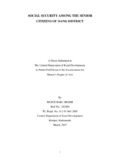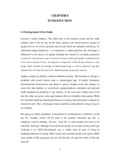Please use this identifier to cite or link to this item:
https://elibrary.tucl.edu.np/handle/123456789/2234| Title: | Social Security Among Theseniorcitizensof Dang District |
| Authors: | Regmi, Mukti Babu |
| Keywords: | Senior Citizen;Livelihood Assets;Resource |
| Issue Date: | 2017 |
| Publisher: | Central Department of Rural Development |
| Abstract: | ThestudyentitledSocial Security among the Senior Citizens of Dang District,isadescriptive explanatory type ofthestudy. Ithas been carried out with the purpose ofassessing the status of old aged people or senior citizens by tracing out theircontemporary status of social security. This study is based on primary data collectedfromBijauriVDC ofDangdistrict, Nepal. The main objectives of the study is to find out the intra family supports andservices provided to elderly people, analyzes the health status, find out the socio-economicmechanism of the community to support elderly members in the family andfind out the extent to what the given senior citizen's allowance offered social securityfor the elderlypeople.The census method of data enumeration is adoptedto all familyin the study area. To find out suchproblems interview is needed, to conduct interview persons ofboth technical and general staffs of senior citizens were directly consulted for interviewbecause they have more information than others. To take information from them Ivisited their homes and family as well as their interaction and information will becollected from them. Leaders social workers and other from the society too wereconsulted and asked them their secrets of success. In this study, age sex, marital status,education status,household carehave beentaken as family support and social security characteristic of household population.Similarly,occupation status, size of home land, household decision, getting elderlyallowanceare taken associo-economicconditionandhealth care system, living status, istaken as health characteristic condition. Likewise, sampling procedure was requiredbecause there were very large numbers of household and among 103 old agerespondents were chosen out from 86 households. The sampling is random but it wasdone purposefully. The male (66%) elderly population is about double than female(34%) elderly population in the study area. Chetri/Brahmin,Tharu,Dalits, Magar, andKumal were included in this study.Themajority were Chetri/Brahmin(46%), followed by Tharu(19%),Dalits (15%), Magar(15%)andKumal (5%). Over domination of aged male over female is evident among theold aged people.Proportion of aged population declines as the age increases.Asobvious the education status isquite poor of the study population, though it is relativelyhighercomparedto national educational statusof dalits population. Majority (41%)areinvolved in agricultural occupation and household decision is generally done byson/daughter. Majority (almost46%) elderly people are passing their time by householdworks. Most of elderly people are able to get allowance. Likewise, most of elderlyexpect love and affection from family. Findings of this study show that the elderly population should have educationalas well as training facilities. There are also problems of food so it should be fulfilled anddiscrimination should be avoided. Furthermore, there should beprovision of communitylevel elderly homes. However, the increasing level of monthly allowance for seniorcitizenssome how has made their lives easy comparing with the past. |
| URI: | http://elibrary.tucl.edu.np/handle/123456789/2234 |
| Appears in Collections: | Rural Development |
Files in This Item:
| File | Description | Size | Format | |
|---|---|---|---|---|
| cover.pdf | 108.34 kB | Adobe PDF |  View/Open | |
| chapter.pdf | 325.09 kB | Adobe PDF |  View/Open |
Items in DSpace are protected by copyright, with all rights reserved, unless otherwise indicated.
